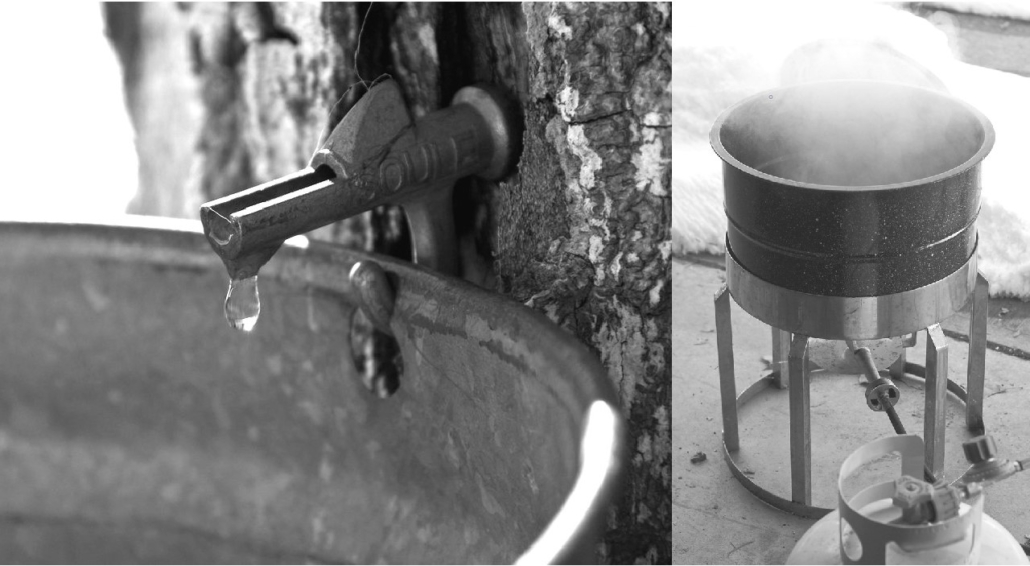GARDEN WORKS: Wake up, sleepy head! Maple syrup time is here

Left, first you gather the sap from the tree using a spout and bucket. Most “backyard” syrup makers use a turkey fryer as an evaporator. It works very well.
 by Emily Cates
by Emily Cates
Wake up, wake up! No more excuses for hibernation or procrastination, Springtime is here. Yes, I know I know — it’s still cold and there’s plenty of snow, each flake erasing an equal amount of motivation to be outside in the garden.
But let’s look at the possibilities anyways, since eventually the window of early-springtime activities will close whether we complete them or not. Why not enjoy a taste of spring by making maple syrup? Let’s whet our appetites by taking a look at this delicious task.
Ah, maple syrup — the amber nectar of our beloved maple tree, made from the sparkling, crystal-clear sap that is a delightful Spring tonic on its own. At 40-45 degrees in the daytime and freezing at night, this luminous sap flows from tree wounds and can be collected.
Maple sugaring supplies are super easy to find at hardware stores or online, and YouTube has an amazing amount of helpful how-to videos.
It is extremely important to use clean, food-grade materials for anything that comes in contact with the sap and syrup. Avoiding trees in polluted areas might is a good idea as well. Also, never overload a tree with too many taps. The best advice I can think of is to use recycled materials if possible, be safe, and to have fun!
To collect the sap, I gather containers such as traditional metal sap pails, water jugs, or buckets. Then, with a 5/16th drill bit, I drill a hole slightly upwards about 2-2 ½ inches, preferably on the south-facing side of the tree. Depending on the setup, I’ll either hang the pails on the tree by the hooks provided on spiles that are gently hammered in the hole, or I run food-grade tubing to a container set on the ground.
Once there’s enough collected, it’s time to strain it and boil it down. Since I only have a small amount of taps and my wood stove is already running this time of year, I usually evaporate the sap in big pots on the stovetop.
40:1 is a common ratio for sap to syrup, which is quite a lot of work for a small amount of product. Oftentimes, depending on how full my hands are this time of year (and how much of it gets raided by my family or myself!), I’ll make the decision to cook with the sap instead of making syrup. I always try to reserve some to slow-cook a chicken…Delicious!
Large quantities of sap are traditionally steamed off in a sugar house with an evaporator suited for many gallons. (I know folks who make a fire in a barrel on its side with foodservice basins fitted on the top.) The sap boils in the basins and is carefully watched, especially as it thickens. Ladle off any foam and impurities from time to time, adding a drop of cream if it threatens to foam over.
Now it’s down to the nitty-gritty! Tell the kids and pets to wait at a safe distance, and put on a pair of steady hands, because this is hot stuff. When the syrup reaches 7 degrees above boiling, or 219 degrees F, it’s ready to carefully strain and pour off into containers. I prefer mason jars, which are handy for canning the syrup. If desired, process in a hot water canner for 10 minutes.
Enjoy maple syrup in as many ways as your imagination allows. How sweet it is to start spring on such a delicious note!
Responsible journalism is hard work!
It is also expensive!
If you enjoy reading The Town Line and the good news we bring you each week, would you consider a donation to help us continue the work we’re doing?
The Town Line is a 501(c)(3) nonprofit private foundation, and all donations are tax deductible under the Internal Revenue Service code.
To help, please visit our online donation page or mail a check payable to The Town Line, PO Box 89, South China, ME 04358. Your contribution is appreciated!


Leave a Reply
Want to join the discussion?Feel free to contribute!